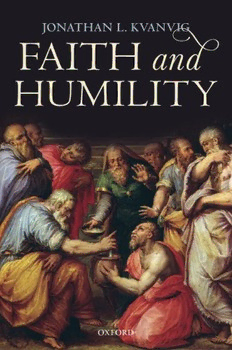
Faith and Humility PDF
Preview Faith and Humility
OUPCORRECTEDPROOF – FINAL,12/4/2018,SPi Faith and Humility OUPCORRECTEDPROOF – FINAL,12/4/2018,SPi OUPCORRECTEDPROOF – FINAL,12/4/2018,SPi Faith and Humility Jonathan L. Kvanvig 1 OUPCORRECTEDPROOF – FINAL,12/4/2018,SPi 3 GreatClarendonStreet,Oxford,OX26DP, UnitedKingdom OxfordUniversityPressisadepartmentoftheUniversityofOxford. ItfurtherstheUniversity’sobjectiveofexcellenceinresearch,scholarship, andeducationbypublishingworldwide.Oxfordisaregisteredtrademarkof OxfordUniversityPressintheUKandincertainothercountries ©JonathanL.Kvanvig2018 Themoralrightsoftheauthorhavebeenasserted FirstEditionpublishedin2018 Impression:1 Allrightsreserved.Nopartofthispublicationmaybereproduced,storedin aretrievalsystem,ortransmitted,inanyformorbyanymeans,withoutthe priorpermissioninwritingofOxfordUniversityPress,orasexpresslypermitted bylaw,bylicenceorundertermsagreedwiththeappropriatereprographics rightsorganization.Enquiriesconcerningreproductionoutsidethescopeofthe aboveshouldbesenttotheRightsDepartment,OxfordUniversityPress,atthe addressabove Youmustnotcirculatethisworkinanyotherform andyoumustimposethissameconditiononanyacquirer PublishedintheUnitedStatesofAmericabyOxfordUniversityPress 198MadisonAvenue,NewYork,NY10016,UnitedStatesofAmerica BritishLibraryCataloguinginPublicationData Dataavailable LibraryofCongressControlNumber:2017963198 ISBN 978–0–19–880948–7 Printedandboundby CPIGroup(UK)Ltd,Croydon,CR04YY LinkstothirdpartywebsitesareprovidedbyOxfordingoodfaithand forinformationonly.Oxforddisclaimsanyresponsibilityforthematerials containedinanythirdpartywebsitereferencedinthiswork. OUPCORRECTEDPROOF – FINAL,12/4/2018,SPi Contents Introduction vii 1. FaithWorthHaving 1 1.1 Introduction 1 1.2 FundamentalityandAxiologicalFundamentality 2 2. CognitiveVersusFunctionalAccounts 9 2.1 Introduction 9 2.2 DiscomfortwithCognitivism 10 2.3 ADispositionalAlternative 14 2.4 LivesofFaith 16 2.5 Conclusion 21 3. Non-CognitiveAccounts 22 3.1 VarietiesofNon-Cognitivism 22 3.2 FaithasTrust 24 3.3 Value-DrivenInquiryandAffectiveFaith 27 3.4 TheInadequacyofTrust-basedAccountsofAffectiveFaith 32 3.5 FaithandPreferences 37 3.6 PreferenceNon-CognitivismandDispositionalNon-Cognitivism 40 3.7 Conclusion 53 4. Dewey,EpistemicFetishism,andClassicalTheism 57 4.1 Introduction 57 4.2 DeweyonFaith 57 4.3 TheFunctionalCharacteroftheAccount 63 4.4 AffectiveFaithandOntologicalCommitment 65 4.5 FromDeweyanFaithtoClassicalTheism 82 4.6 TypesofAppraisalandEpistemicFetishism 91 4.7 Conclusion 101 5. FunctionalFaithinReligiousContexts 103 5.1 Introduction 103 5.2 FaithandtheChristianTradition 105 5.3 SomeMethodologicalReflectionsConcerningtheReceivedView 108 5.4 FaithandBeliefintheContextofScripture 115 5.5 FaithandReason 129 5.6 Conclusion 140 6. Faith,Humility,andVirtuesinIsolation 142 6.1 Introduction 142 6.2 IsHumilityBadforYou? 143 6.3 Holism,Atomism,andComplementarity 148 OUPCORRECTEDPROOF – FINAL,12/4/2018,SPi vi contents 6.4 ACaseStudy:Moses 150 6.5 ReversingtheScales 152 6.6 Conclusion 153 7. ExpressionsofHumilityandEpistemologicalPsychology 156 7.1 Introduction 156 7.2 WeakeningtheContentofBelief 158 7.3 ChangingtheMentalStateReported 161 7.4 ActsandStates 167 7.5 TheEconomyofBelief 168 7.6 CommitmentsasExpressionsofHumility 174 7.7 Conclusion 175 8. TheLogicalSpaceofHumility 177 8.1 Introduction 177 8.2 ContraststoHumilityandModesty 178 8.3 VanityandPride 179 8.4 AThreattoAutonomy? 181 8.5 ConflictingDomains 182 8.6 TwoConceptionsofAutonomy 184 8.7 Conclusion 186 9. Humility:Nature,Value,andVirtue 187 9.1 Introduction 187 9.2 Humility:RelationalorNon-relational? 187 9.3 IntellectualistAccounts 190 9.4 TheVirtuesofAttention 193 9.5 TheNatureofAttention 195 9.6 Conclusion 198 10. Conclusion 199 Bibliography 205 Index 215 OUPCORRECTEDPROOF – FINAL,12/4/2018,SPi Introduction Todayisagooddaytodie.SosaidLowDogbeforetheBattleoftheLittleBighorn in 1876, though often attributed to Crazy Horse. Low Dog’s remark is not best understoodasathreatagainstthe7thCavalrynorasasuicidalremark,butratheras astatementofcommitmenttoacausethatisimportantenoughtodieforifnecessary. Inhisdescriptionofthebattleandhismotivationforparticipating,hetieshisefforts toarejectionoftheideaoflivingnothingbutahumblelife:“WhyshouldIbekeptas ahumbleman,whenIamabravewarriorandonmyownlands?Thegameismine, andthehills,andthevalleys,andthewhitemanhasnorighttosaywhereIshallgo,or whatIshalldo.”AndwhenaskedwhatroleSittingBullplayedinbattle,heisreported tohavesaid,“Ifsomeonewouldlendhimahearthewouldfight.”1 This story is a model of the relationship between faith and humility that I articulatehere.Mygoalinrecountingthestoryisnottoendorsetheideaofarmed conflict or to take sides in the matter of dispute in question, though I note the transformativeexperienceIhaduponreadingBrown(1970)anduponlearningthat thehomesteadlandsettledbymyancestorswastakenbytheUSgovernmentwhen in1868itunilaterallyre-wrotethe1851TreatywiththeSioux.Mygoal,instead,isto seeinLowDog’sremarksthedangerofahumblelifenotbalancedbycommitment togoalsandidealsworthpursuingandhonoring.WhatIseeinhisstanceisawayof livingthataimstobalancetwoimportantvirtues:humilityandfaithworthhaving. InthestoryofLowDog,wecanseethesetwovirtuesfreefromadisconcerting distortionwhenweattendonlytothelanguageoffaithwithinreligiouscontexts.That language,Iwillargue,suffersfromsomethingclosetooriginalsin.Christianityisa paradigmexample.Therewasadream,ahope,apromise,andallofthesecameto beseenbyanoriginalbandoffollowersasbeingembodiedinafirst-centuryJewish man.CommitmenttothecauseofChrististhesourceofthereligionthatfollowed, andthelivesoffaithdisplayedbytheoriginalbandhavethesamecoreelementsasthat displayedbyLowDoginrefusingahumblelifeofsubserviencetowhatevertheUnited Statesgovernmentdemandedofhim.Thereligioninquestion,however,sooncame toportrayfaithintermsofdoctrinalbelief,condemningtoeternaljudgmentthose whorefusedtosignontotheofficialorthodoxy.Moreover,theorthodoxygrowsover time,sothatcognitiveassentisdemandednotonlyconcerningthelife,death,and resurrectionofJesus,butalsoregardingdoctrinesthatarearguablymoreperipheral (suchasVirginBirthandImmaculateConception).Myclaimhereisnotthatthese doctrines are false, but rather that it is a distortion of the fundamental faith of the 1 LowDog’saccountofthebattlewaspublishedintheLeavenworth,KansasWeeklyTimesof18August 1881. OUPCORRECTEDPROOF – FINAL,12/4/2018,SPi viii introduction originalfollowerstoreplacetheircommitmenttoacausewithadoctrinalfaiththat focusesonfactualclaims,justasitwouldbearemarkablymind-bogglingsuggestion to think of the faith displayed by Low Dog in resisting demands of subservience primarilyintermsofwhichclaimshetooktobetrueandwhichfalse. ItisinthesevignettesthatIseethetruenatureoffaithworthhavingandalsothe intimaterelationshipbetweenfaithandhumility.Thisworkisdevotedtoarticulating thisconnectionandexploringthenature,value,andvirtuesoffaithandhumility.The goalistounderstandbothinawaythatdoesnotdiscriminatebetweenreligiousand mundanecontexts,betweensacredandsecular.Itarisesfromaconvictionthatthese twocharactertraitsareimportanttoaflourishinglife,andintimatelyrelatedtoeach otherinsuchawaythatthepresenceofonedemandsthepresenceoftheother. The result of such an inquiry, if that inquiry is successful, will require a re- orienting of discussions surrounding faith, including the interminable and, to my mind,stagnantdebatesabouttherelationshipbetweenfaithandreason.Thosedebates involvesomethingidentifiedasfaith,andthoughitmaybesuch,itisakindoffaith that has never been central to my own experience of a life of faith and one that I don’tfindpresentintheexamplesoffaiththatgripmemost.Thisworkismyattempt to change the conversation, and even though the chances of success are perhaps somewherenearthechancesofsuccessforLowDogtoavoidthelifedemandedby theUSgovernment,itisacauseworthfightingfor. The plan for this book is as follows. I begin with the topic of faith worth having,anddevelopanaccountofthiskindoffaithalongwiththemethodological underpinnings for approaching philosophical questions from such an axiological standpoint.Thesloganfortheviewisthatfaithisadispositioninserviceofanideal, andthesourceoftheviewisinJohnDewey’sACommonFaith,anunder-appreciated workbythisimportantAmericanphilosopher.Thefirstfivechaptersfocusexclusively onfaith,firstinordinary,mundanecontextsandtheninreligiouscontexts,specifically the context of Christian faith. Chapter 6 is the transitional chapter where I argue forthecentralthesisofthiswork,thatfaithandhumilityarebalancingvirtues,andin theremainingchapters,Idevelopanaccountofhumilitythatcanbeusedtosustain thisthesis.TheconclusionisespeciallyimportantinthecontextofChristianity,where faithinChristiscruciallyconnectedwiththehumilityofChristasanexpressionof Divine love, but its importance is not limited to that context. The generality of the resultsispartofthecumulativecaseargumentpresentedfortheimportanceoffaith andhumilityandtherelationshipbetweenthetwo.2 2 ThisworkwassupportedbyagrantfromTempletonReligionTrust.Theopinionsexpressedinthis publicationarethoseoftheauthorandshouldnotbeattributedtotheTempletonReligionTrust. OUPCORRECTEDPROOF – FINAL,12/4/2018,SPi 1 Faith Worth Having 1.1 Introduction We talk about faith and use the language of faith in a multitude of ways: faith in humanity, being a person of faith, having faith that the economy won’t collapse, thecatholicfaith,etc.Faithissometimesusedasasynonymoftrust,sometimesof belief.Suchdiversitypromptsmethodologicalreflection:issystematictreatmenteven possible here, except intaxonomicterms? Pessimismisn’tmuch ofa methodology, though,andthemoreoptimisticwillwanttofollowrecognizablepaths.Thosefamiliar with the linguistic turn in philosophy may seek semantic or conceptual systemati- zation,1 and those of a different methodological persuasion may prefer conceptual genealogy,attemptingahistoricalorperhapsmythicalaccountofwhereourcurrent conceptcomesfromormighthavecomefrom(hopingtoelucidatethephenomenon inquestionintheprocess).2 Onemightalsoproceedmoremetaphysically,looking for something metaphysically fundamental, arguing that one can have equally true butdifferentdescriptionsoftheworld,oneofwhich“cutsnatureatitsjoints”andone whichdoesnot.3 HereIarticulateanddefendadifferentstrategy,onefocusedonfaithworthhaving. Onemightthinkofsuchanapproachasonethatmixesmetaphysicsandvaluetheory, 1 ThebestdefenseoftheneedforsuchisJackson(1998)andJackson(2005). 2 ExamplesofsuchincludeCraig(1990)onknowledgeandWilliams(2002)ontruth.Wewillhave opportunitytolookmorecloselyinalaterchapteratsuchanapproachtotrustdevelopedinSimpson (2012). 3 Astandardexampleisthewhite-black/whack-blitefigure,duetoSider(2011).Thefigureisarectangle composedoftwosquares,oneblackandonewhite.Adiagonallineisthendrawnfromtheupperleftcorner tolowerright,witheverythingabovethelinecountingaswhackandeverythingbelowblite: Regardingthisfigure,itisbothtruththatitishalfwhiteandhalfblackaswellashalfwhackandhalfblite. Butthefirstpurportedly“carvesnatureatitsjoints,”whiletheseconddoesnot.(Itprobablygoeswithout saying,butIwillanyway:thisissueoffundamentalityisametaphysicaltwistonalong-standingproblemin confirmationtheory,thenewriddleofinductionfromNelsonGoodman(1955),replacinggrueandbleen withwhackandblite.)
